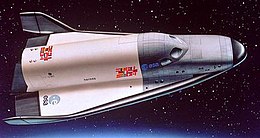 Artist's impression of Hermes | |||
| Designer | Centre National d'Études Spatiales | ||
|---|---|---|---|
| Country of origin | France | ||
| Specifications | |||
| Spacecraft type | Spaceplane | ||
| Launch mass | 21,000 kg (46,000 lb) | ||
| Payload capacity | 3,000 kg (6,600 lb) | ||
| Crew capacity | Three | ||
| Design life | 30 to 90 days | ||
| Production | |||
| Status | Cancelled | ||
| |||
Hermes was a proposed spaceplane designed by the French Centre National d'Études Spatiales (CNES) in 1975, and later by the European Space Agency (ESA). It was superficially similar to the American Boeing X-20 Dyna-Soar and the larger Space Shuttle.
In January 1985, CNES proposed to proceed with Hermes development under the auspices of the ESA.[1][2] Hermes was to have keyed a crewed spaceflight program launched by an Ariane 5 launch vehicle. In November 1987, the project was approved for pre-development from 1988 to 1990, after which authorisation for full development was required. However, the project experienced numerous delays and funding issues.
In 1992, Hermes was cancelled due to high cost and unachievable performance, as well as a partnership with the Russian Aviation and Space Agency (RKA) which reduced the need for an independent spaceplane. As a result, no Hermes shuttles were ever built. During the 2010s, it was proposed to resurrect the Hermes vehicle as a partially reusable air-launched spaceplane launch system, known as SOAR.
- ^ Martin Bayer, Hermes: Learning from our mistakes, Space Policy, Volume 11, Number 3, August 1995, pp. 171-180(10)
- ^ Howell, Elizabeth (February 9, 2015). "Europe's Experimental Mini-Space Shuttle to Launch Wednesday". Space.com.